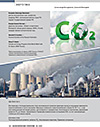Impact of Post-Industrial Processes on the World Power Engineering and CO2 Emissions
Transition to the postindustrial phase of the economic development is characterized by saturation in dependence of energy consumption from economic growth. Maximum of global energy use equal to 25–30 G toe and twofold of the current level is expected in the middle of the century. Perspectives of CO2 emission limitation by the level determined by the UN Paris climate agreement are analyzed by transformation of global energy sources.
References:
- Bell D. Gryadushchee postindustrial’noe obshchestvo. Opyt sotsial’nogo prognozirovaniya [The Coming of Post-Industrial Society. Experience of Social Forecasting]. Moscow, Academia, 2004. 768 p.
- Glaz’ev S.Yu., L’vov D.S., Fetisov G.G. Evolyutsiya tekhniko-ekonomicheskikh sistem: vozmozhnosti i granitsy tsentralizovannogo regulirovaniya [Evolution of Technical-Economic Systems: Possibilities and Boundaries of Centralized Regulation]. Moscow, Nauka, 1992.
- UNEP, 2016. The Emissions Gap Report 2016. United Nations Environment Programme (UNEP), Nairobi, 86 p.
- Kokorin A.O. Izmeneniya klimata kak osnova Parizhskogo soglasheniya [Climate Changes as Basis of the Paris Agreement]. Energeticheskaya politika, 2017, no 4.
- Kosarikov A.N. Rol’ al’ternativnoy energetiki v sderzhivanii krizisa [The Role of Alternative Power Engineering in the Crisis Containment]. Ekonomicheskie strategii, 2009, no 2, pp. 38–41.
- Prognoz razvitiya energetiki mira i Rossii 2016 [Global and Russian Energy Outlook 2016]. Pod redaktsiey A.A. Makarova, L.M. Grigor’eva, T.A. Mitrovoy. Institut energeticheskikh issledovaniy RAN; Analiticheskiy tsentr pri Pravitel’stve RF, 2016, 197 p., available at: http://ac.gov.ru/files/publication/a/10585.pdf.
- GEA, 2012. Global Energy Assessment — Toward a Sustainable Future, Cambridge University Press, Cambridge UK and New York, NY, USA and the International Institute for Applied Systems Analysis, Laxenburg, Austria. 1884 p.
- IEA WEO, World Energy Outlook 2016. International Energy Agency, Paris, France, 684 pp., available at: http://www.iea.org/newsroom/news/2016/ november/world-energy-outlook-2016.html.
- Sustainable Finance Programme, Working Paper. August 2017. The fate of European coal-fired power stations planned in the mid-2000s. Smith School of Enterprise and the Environment. University of Oxford. 87 p., available at: www.smithschool.ox.ac.uk/research/stranded-assets/
- IEA Statistics. Key World Energy Trends Excerpt from World energy balances (2016 edition), available at: www.iea.org/statistics/topics/energybalances/
- World Population Prospects. The 2017 Revision. United Nations, New York. 2017. 53 p., available at: https://esa.un.org/unpd/Wpp/Publications/Files/WPP2017_KeyFindings.pdf.
- New Energy Outlook 2017. Bloomberg New Energy Finance. Executive Summary. June 2017. 6 p.
- Energeticheskaya strategiya Rossii na period do 2035. Ministerstvo energetiki Rossiyskoy Federatsii (proekt ot 1 fevralya 2017 g.) [Energy Strategy of Russia by 2035. Ministry of Energy of the Russian Federation. Draft of 01.02.2017]. Ministerstvo energetiki RF, available at: http://minenergo.gov.ru/node/1920.



